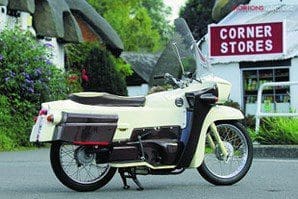
With hindsight, it’s obvious that the Velocette Vogue was doomed from the start. Since 1948 the company’s enclosed LE had been available to a largely disinterested public, and it had nearly scuppered the business when it failed to sell in adequate quantities; only surviving by the skin of its teeth when the civil authorities – notably the rural police – purchased something like half of the total number produced. But Velocette’s management had seemingly learnt nothing from the debacle, and 15 years later decided to launch yet another ‘car on two wheels’.
Admittedly, the LE was a delightful little motorcycle when taken on its own terms, but it missed its intended targets by a mile. Besides the fact that existing motorcyclists would never be tempted onto something so puny, it didn’t offer enough protection from the elements to wean drivers out of their cars, and it was too expensive for realistic consideration by either class of potential user.
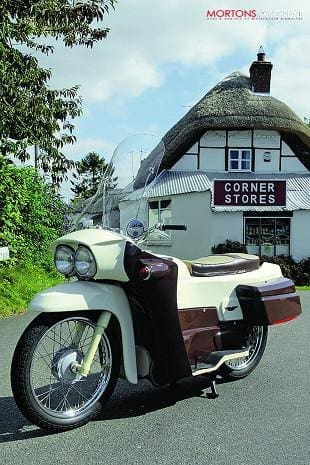 The LE’s plus points included a sophisticated beam frame that provided excellent handling, and it wasn’t bad looking, apart from its angular leg shields. Its biggest drawback was the engine. A side valve unit had been chosen by designer Charles Udall for the valid reasons that it was compact enough to be used in a vibration-less flat-twin format, and it was simpler to water cool (which added sophistication and mechanical quietness). Unfortunately, the emphasis had been so much focused on the mythical commuting buyer during the ‘Little Engine’s’ development, that it wasn’t economic to increase its capacity above 192cc, even when it became obvious that more power would enhance its sales prospects.
The LE’s plus points included a sophisticated beam frame that provided excellent handling, and it wasn’t bad looking, apart from its angular leg shields. Its biggest drawback was the engine. A side valve unit had been chosen by designer Charles Udall for the valid reasons that it was compact enough to be used in a vibration-less flat-twin format, and it was simpler to water cool (which added sophistication and mechanical quietness). Unfortunately, the emphasis had been so much focused on the mythical commuting buyer during the ‘Little Engine’s’ development, that it wasn’t economic to increase its capacity above 192cc, even when it became obvious that more power would enhance its sales prospects.
So what did Velocette do with the new Vogue announced in late 1962? The firm kept the poor little engine – the limitations of which were even more glaringly obvious than when it had been introduced all those years earlier – and replaced its pressed steel beam with a new, but arguably less advanced, tubular frame, and cloaked the whole thing in bulkier and weightier bodywork.
My late friend, the Avon fairing company’s Doug Mitchenall, was responsible for the design and production of the new Velocette’s glass-fibre bodywork, and he was brutally frank about its genesis and prospects. “It would never have happened,” he told me, “except that Velocette boss Bertie Goodman and I had a little too much wine at dinner one night. He started chatting about how he’d like to update the LE, so I started doodling on a napkin, and we came up with the outlines of the Vogue.”
I can believe all that, after all, many of us must have discussed our ideal motorcycle over a few glasses of plonk, but – perhaps fortunately – we haven’t had the luxury of seeing what our project would look like in the cold light of day.
The Vogue was first seen at the 1962 Earls Court Show, when it seems to have created more curiosity than enthusiasm. In any case, it didn’t become available for sale until the middle of the following year, by which time many potential buyers may have had second thoughts. The Vogue stayed in production until 1968, but it probably only survived that long because the engine/gearbox unit was still being made for the Police LEs, so it cost little to occasionally fit one in the new frame, while a few sets of the GRP bodywork could be made as and when required.
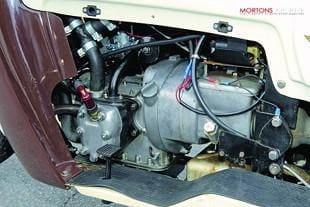 If all that sounds rather downbeat, I don’t think I’m misrepresenting the situation, or exaggerating the lack of customer interest. During the five years the Vogue was available, well under 400 were sold, and a production rate of about one-and-a-half per week wasn’t going to keep the Velocette boardroom supplied with caviar and champagne, was it? A surprisingly high proportion seem to have survived, judging by the regularity with which they appear in ‘For Sale’ advertisements, and the cynic in me suggests that that might be because few saw enough work to get worn out, and they are no more popular now than when they were being made.
If all that sounds rather downbeat, I don’t think I’m misrepresenting the situation, or exaggerating the lack of customer interest. During the five years the Vogue was available, well under 400 were sold, and a production rate of about one-and-a-half per week wasn’t going to keep the Velocette boardroom supplied with caviar and champagne, was it? A surprisingly high proportion seem to have survived, judging by the regularity with which they appear in ‘For Sale’ advertisements, and the cynic in me suggests that that might be because few saw enough work to get worn out, and they are no more popular now than when they were being made.
Having said all that, I have to put the other side of the coin, and admit that the archetypical reluctant motorist Bertie Goodman was seeking does actually exist. One local chap – a stalwart of the Velocette flat twin club – has used his Vogue on a daily basis for many years, while his car stays in the garage except when essential to carry heavy loads. But he is the exception that proves the rule and most Vogues remain firmly as curiosities in collections.
So (to pen the sort of link beloved of radio presenters) my curiosity was aroused when I heard that Hampshire-based Velocette fanatic Neil Redley had added a Vogue to his collection, and before I take to the saddle, he runs through the interesting story behind the Vogue’s restoration.
 “It’s quite a far-travelled motorcycle,” he tells me, “It was initially bought in December 1963 from Wills Brothers of Kingsbridge in Devon, and the first owner kept it for quite a while before passing it on to another local chap. Its history then gets a bit blurred until it turned up as a basket case in Birmingham, from where it was bought by Velocette Club member Brian Agnew, who is Reader in Thermal Systems at the School of Mechanical and Systems Engineering in Newcastle University.
“It’s quite a far-travelled motorcycle,” he tells me, “It was initially bought in December 1963 from Wills Brothers of Kingsbridge in Devon, and the first owner kept it for quite a while before passing it on to another local chap. Its history then gets a bit blurred until it turned up as a basket case in Birmingham, from where it was bought by Velocette Club member Brian Agnew, who is Reader in Thermal Systems at the School of Mechanical and Systems Engineering in Newcastle University.
“Brian was already restoring another Vogue which some previous owner had unaccountably fitted with LE legshields, and which was missing a side panel, so he decided to make use of his new acquisition to aid that project. He made moulds of its legshields and panels in his own time, and then had his pupils lay up new GRP components in them as a class exercise. After making a few more parts for other club members he passed the moulds onto the Velocette Flat Twin Club, so there may be several Vogues on the road that wouldn’t be complete if it hadn’t been for the one I now own.
“Anyway,” Neil continues, “Brian built this one up from the best parts at his disposal, and I brought it back south a year or so ago. It ran all right except for an annoying misfire, which I eventually traced to faulty carburettor parts. The tiny Amal carburettor was unique to this model and currently unavailable, so when I heard that Dell’Orto sold a direct replacement I fitted one and it completely solved the problem. It doesn’t have a tickler, so I’ve connected its cold-start device to a valve lifting lever on the handlebars. The ignition can also cause difficulties with flat twin Velos, but Brian used a Boyer Branson system where only the minimal current needed to trigger the electronics passes though the points, so they keep their adjustment.”
‘During its travels, the Vogue had become parted from its original registration number, and now wears a quite presentable Newcastle age-related replacement. Interestingly, the original number didn’t denote the year of sale with an ‘A’ suffix, because this system was initially optional and the Exeter Vehicle Records Office felt it was a bit of bureaucracy they’d ignore as long as they could.’
During its travels, the Vogue had become parted from its original registration number, and now wears a quite presentable Newcastle age-related replacement. Interestingly, the original number didn’t denote the year of sale with an ‘A’ suffix, because this system was initially optional and the Exeter Vehicle Records Office felt it was a bit of bureaucracy they’d ignore as long as they could.
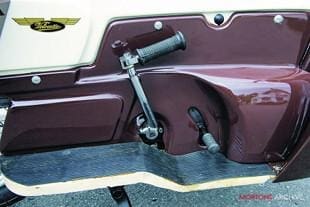 Despite owning bigger and faster bikes, Neil really likes the way he can ride his Vogue out for a civilised potter early on a Sunday morning, so when I took it out I was rather hoping that my preconceptions would prove unfounded. It would have been nice to report that 1960s motorcyclists didn’t know a good thing when it was presented to them, but I’m forced to agree with them that this machine – smart and innovative though it is – doesn’t really cut the mustard.
Despite owning bigger and faster bikes, Neil really likes the way he can ride his Vogue out for a civilised potter early on a Sunday morning, so when I took it out I was rather hoping that my preconceptions would prove unfounded. It would have been nice to report that 1960s motorcyclists didn’t know a good thing when it was presented to them, but I’m forced to agree with them that this machine – smart and innovative though it is – doesn’t really cut the mustard.
First impressions are hopeful, though, as the combination of semi-electronic ignition and a new carburettor mean a first-kick start, cold or hot. Press-start would actually be a better expression, as the odd internal mechanism inherited from the Little Engine’s original hand-starting lever, plus the proximity of the footboards, mean that the lever has a movement of less than a right angle.
Initial acceleration is encouraging, too, the broad power band and four sensibly spaced gear ratios masking the fact that the side-valve engine produces less power than even the equivalently sized contemporary Villiers unit. But there the good news stops, because this is a seriously weedy motorcycle. If it is more streamlined than the identically powered LE, any benefit is cancelled out by its greater size and weight, and the Vogue’s shortcomings on the open road are emphasised by bodywork that includes indicators and panniers (albeit with awkwardly narrow openings), which give it pretensions towards being a tourer rather than just a ride-to-work commuter.
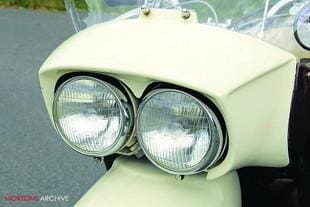 To put figures on its performance, the Velocette will cruise at 50mph on a level road, but a modest uphill slope, or a headwind, soon puts paid to that, while a combination of the two results in a humiliating drop to third gear and a 30mph grind. At one stage in my test I became surrounded by a posse of police motorcyclists on a training ride-out, and I was seriously concerned that my inability to keep up to a 50mph speed limit might make them suspect I had something to hide.
To put figures on its performance, the Velocette will cruise at 50mph on a level road, but a modest uphill slope, or a headwind, soon puts paid to that, while a combination of the two results in a humiliating drop to third gear and a 30mph grind. At one stage in my test I became surrounded by a posse of police motorcyclists on a training ride-out, and I was seriously concerned that my inability to keep up to a 50mph speed limit might make them suspect I had something to hide.
Comfort for the rider is quite good, although I find the brake and gear levers stop me placing my feet exactly where I would like on the footboards, and find it strange that their design – intended for the original hand-start, hand-gearchange LE – should be perpetuated here.
Thankfully, it doesn’t rain during my ride, but I imagine that weather protection would be pretty effective, as the screen is ideally angled to deflect the wind above my head, despite being low enough to see over. I detect Doug Mitchenall’s expertise here, as he was among the first men, outside factory race teams, to explore the airflow past moving motorcycles while developing his Avon screens and fairings. The Vogue looks good, too, only the fake flutes behind the seat betraying the design’s leanings towards the worst excesses of 1960s car styling.
Effective streamlining puts more strain on the brakes, of course, but those on the Vogue are by no means over-sized or impressively effective. Interestingly, though, the motor’s characteristics of having little flywheel effect, but lots of moving parts, comes to the rider’s defence, and closing the throttle results in a reassuring and surprising amount of engine-braking.
 The roadholding is competent on the whole, an initial tendency towards heaviness changing to impressive stability as the speed rises. The effect is rather spoilt, though, by undamped forks that become somewhat pogo-like when encountering a bump in mid-bend. It’s that odd contrast between expectation and delivery again, I suppose. If one was happy to treat the Vogue as a sort of big-wheeled Vespa it would excel in all respects, but its looks and cost (50 per cent greater than even the top of the range Vespa) lead one to expect rather more than it can provide.
The roadholding is competent on the whole, an initial tendency towards heaviness changing to impressive stability as the speed rises. The effect is rather spoilt, though, by undamped forks that become somewhat pogo-like when encountering a bump in mid-bend. It’s that odd contrast between expectation and delivery again, I suppose. If one was happy to treat the Vogue as a sort of big-wheeled Vespa it would excel in all respects, but its looks and cost (50 per cent greater than even the top of the range Vespa) lead one to expect rather more than it can provide.
The Vogue’s nearest rival was, of course, not the Vespa but the Ariel Leader, and Neil Redley also has one of those I’ll report on separately. It can’t be ignored though, as its initial and spectacular success was doubtless among the factors that persuaded Bertie Goodman there might be some mileage in having another tilt at the ‘motorcycle for everyman’ concept.
He would have done better to study the downside of the Leader’s story, as the first flush of enthusiasm quickly evaporated, and, to maintain sales, the enclosed model had to be supplemented by the more-conventional looking Ariel Arrow within a year or so. Soon there was a general decline in motorcycle sales and by the time the Vogue was announced the Leader was well and truly on the skids. In the circumstances, it’s difficult to find words other than ‘economic suicide’ to describe the launch of a similarly styled motorcycle with a price tag 10 per cent higher and a top speed that was lower by a rather greater margin!
Against all the evidence that most motorcyclists were only interested in Velocette’s roadburners, Bertie Goodman quixotically persisted in his belief that a significant number would warm to the company’s smaller enclosed machines. The test machine first whispered onto the road in December 1963, with a frame number indicating that in almost a year of production only about 100 had been sold, and sadly, that tells you just how wrong he was.



